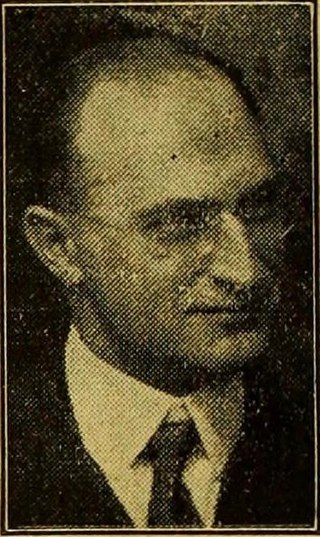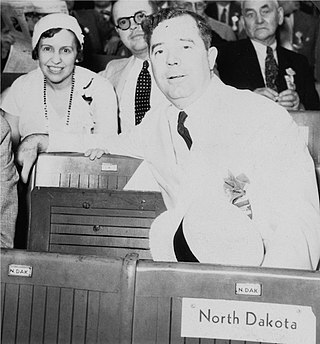
Huey Pierce Long Jr., byname "The Kingfish", was an American politician who served as the 40th governor of Louisiana from 1928 to 1932 and as a United States senator from 1932 until his assassination in 1935. He was a left-wing populist member of the Democratic Party and rose to national prominence during the Great Depression for his vocal criticism of President Franklin D. Roosevelt and his New Deal, which Long deemed insufficiently radical. As the political leader of Louisiana, he commanded wide networks of supporters and often took forceful action. A controversial figure, Long is celebrated as a populist champion of the poor or, conversely, denounced as a fascistic demagogue.
The Panic of 1819 was the first widespread and durable financial crisis in the United States that slowed westward expansion in the Cotton Belt and was followed by a general collapse of the American economy that persisted through 1821. The Panic heralded the transition of the nation from its colonial commercial status with Europe toward an independent economy.

Share Our Wealth was a movement that began in February 1934, during the Great Depression, by Huey Long, a governor and later United States Senator from Louisiana. Long first proposed the plan in a national radio address, which is now referred to as the "Share Our Wealth Speech". To stimulate the economy, the Share Our Wealth program called for massive federal spending, a wealth tax, and wealth redistribution. These proposals drew wide support, with millions joining local Share Our Wealth clubs. Roosevelt adopted many of these proposals in the Second New Deal.

William Henry Davis "Alfalfa Bill" Murray was an American educator, lawyer, and politician who became active in Oklahoma before statehood as legal adviser to Governor Douglas H. Johnston of the Chickasaw Nation. Although not American Indian, he was appointed by Johnston as the Chickasaw delegate to the 1905 Convention for the proposed State of Sequoyah. Later he was elected as a delegate to the 1906 constitutional convention for the proposed state of Oklahoma; it was admitted in 1907.

John Garland Pollard was a Virginia lawyer and American Democratic politician, who served as the 21st Attorney General of Virginia (1914-1918) and as the 51st Governor of Virginia, as well as on the Federal Trade Commission (1919-1921) and as chairman of the Board of Veterans Appeals (1934-1937).

Alvin Olin King was an American politician allied with the Democratic faction of Governor Huey Pierce Long Jr. A state senator, he was President Pro Tempore in 1931, after Long had been elected in 1930 as a US Senator.

The Louisiana State Capitol is the seat of government for the U.S. state of Louisiana and is located in downtown Baton Rouge. The capitol houses the chambers for the Louisiana State Legislature, made up of the House of Representatives and the Senate, as well as the office of the Governor of Louisiana. At 450 feet (137 m) tall and with 34 stories, it is the tallest skyscraper in Baton Rouge, the seventh tallest building in Louisiana, and tallest capitol in the United States. It is located on a 27-acre (110,000 m2) tract, which includes the capitol gardens. The Louisiana State Capitol is often thought of as "Huey Long's monument" due to the influence of the former Governor and U.S. Senator in getting the capitol built. The building's construction was completed in 1931. It was listed on the National Register of Historic Places in 1978 and was designated a National Historic Landmark in 1982.

Ruby Laffoon was an American attorney and politician who served as the 43rd Governor of Kentucky from 1931 to 1935. A Kentucky native, at age 17, Laffoon moved to Washington, D.C., to live with his uncle, U.S. Representative Polk Laffoon. He developed an interest in politics and returned to Kentucky, where he compiled a mixed record of victories and defeats in elections at the county and state levels. In 1931, he was chosen as the Democratic gubernatorial nominee by a nominating convention, not a primary, making him the only Kentucky gubernatorial candidate to be chosen by a convention after 1903. In the general election, he defeated Republican William B. Harrison by what was then the largest margin of victory in Kentucky gubernatorial history.

Richard Webster Leche was an American attorney, judge, and politician, elected as the 44th Governor of the U.S. state of Louisiana. He served from 1936 until 1939, when he resigned. Convicted on federal charges of misuse of federal funds, Leche was the first Louisiana chief executive to be imprisoned.

Joseph Eugene Ransdell was an attorney and politician from Louisiana. Beginning in 1899, he was elected for seven consecutive terms as United States representative from Louisiana's 5th congressional district. He subsequently served for three terms in the United States Senate from Louisiana before being defeated in the 1930 Democratic primary for the seat by Governor Huey Long.

Thomas Semmes Walmsley was the mayor of New Orleans, Louisiana from July 1929 to June 1936. He is best known for his intense rivalry, reconciliation, and then resumption of hostilities with Governor Huey Pierce Long, Jr.
The Long family is a family of politicians from the United States. Many have characterized it as a political dynasty. After Huey Long's 1935 assassination, a family dynasty emerged: his brother Earl was elected lieutenant-governor in 1936, and governor in 1948 and 1956. Long's widow, Rose McConnell Long, was appointed to replace him in the Senate, and his son Russell B. Long, was a U.S. senator from 1948 to 1987. As chairman of the Senate Finance Committee, Russell shaped the nation's tax laws. He was an advocate of low business taxes, but also passed the Earned Income Credit and other tax legislation beneficial to the poor. In addition to Long's brother Earl K. Long becoming governor, brother Julius Long was a Winn Parish District Attorney, and brother George S. Long was elected to Congress in 1952. Other more distant relatives, including Gillis William Long and Speedy O. Long, represented Louisiana in the U.S. Congress. Jimmy D. Long of Natchitoches Parish served for 32 years in the Louisiana House. Jimmy's younger brother Gerald Long holds the distinction of being the first office-holder to be a registered Republican among the Long Democratic dynasty.

The 1932 United States Senate election in Arkansas took place on November 8, 1932. Incumbent Senator Hattie Caraway, who had been appointed to succeed her late husband Thaddeus Caraway in 1931 and won a special election to complete his term in January, ran for a full term in office.
Clifford Cleveland Brooks, also known as C. C. Brooks, was a Georgia native who served as a Democrat from 1924 to 1932 in the Louisiana State Senate. Brooks represented the delta parishes: Tensas, Madison, East Carroll, and Concordia, a rich farming region along the Mississippi River in eastern Louisiana ranging from Vidalia to Tallulah to Lake Providence. At the time, two state senators served from the four-parish district.

Henry Clay "Happy" Sevier, Sr. was a lawyer and politician from Tallulah, Louisiana. One of a large political family, he served from 1936 to 1952 as a Democratic member of the Louisiana House of Representatives from Madison Parish.
Leonard Mason Spencer was a lawyer and planter from Tallulah, Louisiana, who was from 1924 to 1936 a Democratic member of the Louisiana House of Representatives for Madison Parish, located alongside the rich farming delta of the Mississippi River.

Norris Charles Craft Williamson was a Democrat who served from 1924 to 1932 in the Louisiana State Senate. A resident of Lake Providence, Williamson represented the delta parishes: Tensas, Madison, East Carroll, and Concordia, a rich farming region along the Mississippi River. Included in his district were Vidalia, Ferriday, St. Joseph, and Tallulah. At the time, two state senators represented the four-parish district.

The 1932 United States presidential election in Louisiana took place on November 8, 1932, as part of the 1932 United States presidential election. Louisiana voters chose ten representatives, or electors, to the Electoral College, who voted for president and vice president.

Huey Long, the former governor of Louisiana, served in the United States Senate from 1932 until his assassination in 1935. A powerful figure, Long was integral in Franklin Roosevelt's 1932 Democratic Nomination and the election of the first woman, Hattie Caraway, to the US Senate. He was investigated for election discrepancies regarding the election of his friend John H. Overton, but no evidence of fraud was found. He proposed sweeping legislation, known as the Share Our Wealth plan, to end the Great Depression. Long often used filibusters to prevent or slow the passage of New Deal legislation.
Paul Narcisse Cyr DDS, nicknamed the "Wild Bull of Jeanerette", was an American politician, dentist, banker, and geologist, who served as Lieutenant Governor of Louisiana from 1928 to 1931, unsuccessfully declared himself Governor of Louisiana, and was first an ally and then an opponent of Governor Huey Long.


















